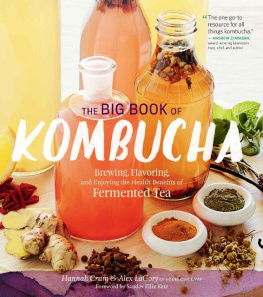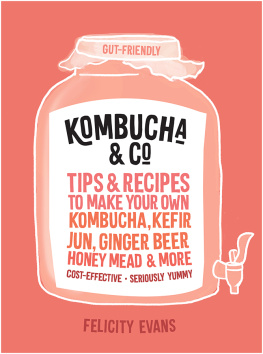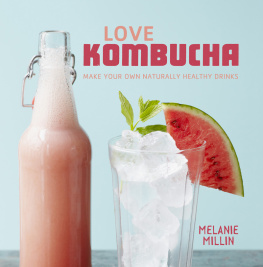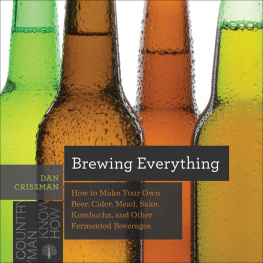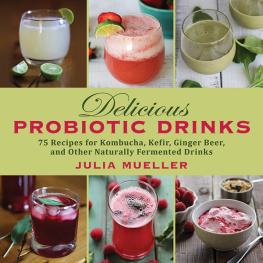To all bacteria-powered organisms, living in symbiosis everywhere. The more we know, the more we grow, together.
Contents
A Note from GT Dave
Kombucha came into my life over 20 years ago and changed me forever. My parents, who received a kombucha culture from a close family friend, began making and drinking kombucha in our home. I noticed how they quickly fell in love with how good it made them feel and look. But it wasnt until my moms battle with breast cancer that I truly realized the magnitude of kombuchas health properties. Her doctors marveled and I observed firsthand how it kept her strong and resilient all the way through her recovery. It was then that I became convinced that kombucha was a gift that had blessed my family and that it needed to be shared with the world.
Hannah and I have both experienced that it is an understatement to say that kombucha is a life changer. It restores balance in the digestion, rejuvenates the immune system, and revitalizes the mind. It unlocks an enlightened way of thinking and living by putting you back in touch with your body.
Kombucha is also an instrument for finding more ways to be healthier and therefore happier. Through its symbiotic cycle of life with the mother and baby SCOBY, its a constant reminder that we need to seek the life force in all our food and to surround ourselves with love and positive energy. Whether you make your own kombucha or have it made for you, within this book youll discover the impact that it can have on your life; it may change you forever.
GT Dave
Founder and President of GTs Kombucha
Foreword
Kombucha, fermented sweet tea, has become the drink of the new millennium. Not that its new, because it isnt. Like all fermented foods and beverages, it is ancient and its specific origins are murky. But until the dawn of the new millennium, it was not commercially available, and it was spread exclusively through grassroots channels.
The starter for kombucha is a rubbery disk known as the mother, a symbiotic culture of bacteria and yeast (SCOBY), which grows a new layer and thickens with each batch. As enthusiasts grew more and more mothers, they sought to share them, often with evangelical zeal.
I first encountered kombucha around 1994, when a friend with AIDS, who was dealing with a major health crisis, got drawn into kombucha for its reputed immune benefits. Soon he had a stack of mothers and started giving them to his friends to take home.
The grassroots spread of kombucha continues, but it has also spawned an industry, with U.S. annual sales now estimated at $600 million and steadily growing. This book is written by two people who have devoted themselves to kombuchas continued success. Hannah and Alex teach workshops, sell kombucha mothers and kits, and organize small producers, and now they have written this book.
The Big Book of Kombucha will certainly alleviate any fears you might have about making your own kombucha. It is full of ideas for innovative ways to flavor kombucha and has a very thorough troubleshooting section. The authors promote kombucha as a healing tonic, but do so in a balanced way, backed by citations to research (in contrast to some unsubstantiated hype). As much as I love kombucha (and sauerkraut and kefir and many other ferments), it is not reasonable to expect any single food or beverage to cure specific diseases.
I bring up these other ferments because kombucha exists in a much broader context of foods and beverages transformed by the action of microorganisms. According to one estimate, one-third of all food that human beings consume has been fermented before we eat it. Bread, cheese, and cured meats are fermented. Sauerkraut, kimchi, olives, and certain styles of pickles are fermented. So are soy sauce, fish sauce, and the vinegar found in most other condiments. Coffee, chocolate, and vanilla are fermented, as are wines and beers. Flavors of fermentation are prominent not only in Western cuisines but also around the world. In many diverse locales ferments are essential everyday foods. I have been unable to find a single example of a culinary tradition that does not incorporate fermentation.
Fermentation preserves food, makes it more flavorful and digestible, makes nutrients more bioavailable, breaks down certain toxic compounds, and produces others that are beneficial. I hope that as this book is your gateway to kombucha; kombucha will be your gateway to fermentation.
Welcome to the fermentation revival!
Sandor Ellix Katz
Author of The Art of Fermentation and Wild Fermentation
Preface
Our Kombucha Journey
from Hannah
Kombucha Kismet whenever people ask how I first discovered kombucha, that is how I describe the experience. In Turkish, kismet means fate or your lot in life and is derived from the Arabic root word qasama (to divide). As someone who enjoys digging into the root of problems, words, and mysteries (Im a total word nerd!), looking back it makes sense that my first experience with kombucha in 2003 marked a clear divide in my life path. At the time, it was simply a curious stop on a fun tour of a college friends groovy San Francisco apartment, full of neat things I hadnt considered: a filter on the shower head (of course, get the chlorine off your skin!), pink Himalayan salt (salt is good for you?), and kombucha. While Alex and I didnt even taste their homebrew (not ready yet), my appetite to learn more had been piqued.
Not until a week later, when I purchased a couple of bottles at the West LA Whole Foods, did I even get my first taste. The bright-white lights of the display case illuminated the neat rows of amber and jewel-toned liquid, complete with similar floating globs to the jars I had spied in San Francisco. I couldnt wait to finally sip this mysterious brew, so I popped a bottle right there in the aisle before checking out, and when the tangy GTs Gingerade hit my tongue, wow! It was electric! Every nerve ending in my body instantly lit up, and in hindsight, I do recall angels in heaven singing hallelujah as divine light shone around me and the kombucha LOVE at first sip!
(True confession: when I was a kid, Mom would often admonish me for sneaking slugs of sour, briny pickle juice right from the jar, even before the pickles were gone! She was worried it was bad for me, but the salty tang was irresistible.)
The Chinese say, A journey of a thousand miles begins with a single step. For me, that first sip of kombucha was my single step on a journey of evolution and transformation, more than a decade long, that continues to this day.
My store-bought kombucha thirst quickly escalated beyond my budget, and getting my own magic jars and brewing at home became a necessity. For a girl whose idea of cooking was pressing the start button on the microwave, taking up a kitchen hobby might have seemed counterintuitive, but I trusted my gut and went hunting for a kombucha culture, which I sourced locally through the interweb. A friend was kind enough to pick it up for me, but I realized too late that I had forgotten to tell her exactly what a kombucha baby was. I felt bad but it was entertaining to see her face when she arrived at my doorstep, white as a sheet, holding the plastic baggie at arms length and demanding, What the heck is this? An alien blob? A placenta?

